For the sake of your own sanity, please make japchae vegan. No need to cook and slice meat and egg in this recipe, since you have enough things to do in your life already. You are enough, and the veggies are enough.

This is a one pot meal that could only be enhanced with some piquant side dishes such as Quick, Vegan Cucumber Kimchi (in 30 minutes!), napa cabbage kimchi, or angry, smashed cucumbers.
What are japchae noodles?
Sometimes spelled Chap Chae or referred to as Korean glass noodles, these are gluten free noodles that just might make you throw rocks at your grandma.
They are clear noodles made from sweet potato starch. They take about 6-7 minutes to cook in boiling water and have a somewhat chewy texture and neutral flavor.
Because of their "Swiss" status, they wear the colors and flavors of whatever you put into it, and they can be served at room temperature. Soy sauce (or tamari) and sesame oil are classic seasonings for these noodles.
While chapchae noodles are classically used in this dish, they are also found in warming Korean soups such as yukgaejang and seolleongtang, a beef bone broth.
They are known as dang myun vermicelli in Korean.
What japchae noodles are not
Japchae noodles are made from sweet potato starch. They are not:
- Sweet potatoes cut with a spiralizer to look like noodles
- Mung bean noodles, also called glass noodles, used in Chinese, Thai, and Vietnamese cuisines
Are japchae noodles healthy?
They are gluten free, but they are made from a starch just like wheat noodles. The question is whether sweet potato starch is healthier than wheat flour.
Looking at the nutrition info for the Sempio brand of sweet potato noodles, a ½ pound of noodles yields:
- 792 calories
- 0 g fat
- 22 g sodium
- 198 g carbohydrates
- 0 g protein
- 0 vitamins
A ½ pound of noodles, yields approximately 4 c of cooked pasta. See the recipe card below for full nutrition info of these noodles using the japchae recipe.
It has no vitamins because it is not enriched with vitamins as many wheat pastas are. In addition, it has no fat or protein, just carbs.
These are definitely not keto-friendly noodles, but they are gluten free. Unlike wheat noodles, you won't miss the lack of cheese 0r cream making these noodles a great dairy free recipe option too.
Substitute for sweet potato noodles
If you don't care to search for Korean sweet potato noodles, you could also use mung bean noodles or angel hair wheat pasta.
But in all honesty, if you don't have them, you may as well make a different dish.
There are many brands available, but I have not found a distinguishable difference between them.
What is japchae made of?
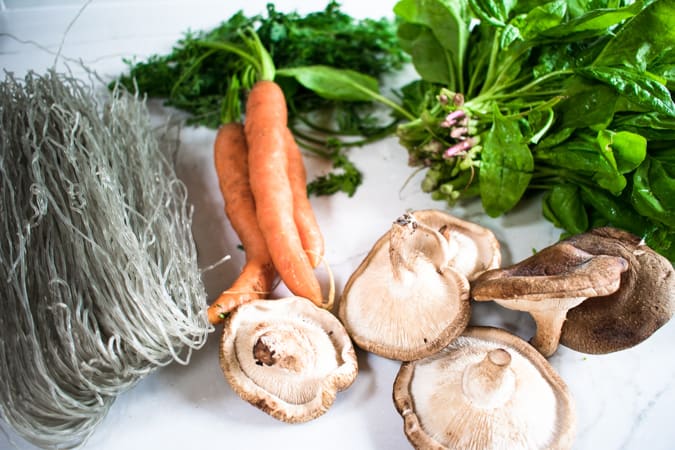
You will need:
- Korean sweet potato noodles
- Onion - for umami
- Carrots - for sweetness
- Spinach - for dark green vegginess
- Shiitake mushrooms or woodear mushrooms (fresh or rehydrated from the dried version) - for earthiness
The Secret Sauce
- Soy sauce (or Tamari sauce)
- Fresh minced garlic
- black pepper
- A touch of sugar
Authentic Japchae recipe
If you want to make it “authentic” here is what not to do. Don't add whatever you have in your fridge such as red bell peppers, tofu, and kale.
Keep out the swiss chard, and don't even think about button mushrooms, asparagus, and green beans.
This dish is traditionally made with beef strips, egg strips, spinach (or other Korean dark leafy green), carrots, onion, and shiitake or woodear mushrooms.
Go to any Korean supermarket, and you'll see the japchae with the vegetables listed above wrapped in plastic on styrofoam trays.
Go to a Korean restaurant, and you might see a different version of japchae.
Restaurant Japchae
Order japchae at Gen Korean BBQ House, and all you will get is the noodles. They don't even bother adding vegetables because that would be too much work.
So why are we doing this?
How to make japchae better @home
Trust me, I'm the last person that wants to invest disposable time making Asian rainbow noodles. But you can make a much nicer version at home with these seemingly simple steps.
- Use organic spinach and carrots
- Don't add too much sugar or oil. It can tend to be too sweet or greasy.
- Make it with love in your heart (the hardest part when there is so much darn chopping and stir frying in this dish that is an exercise in patience).
- Make a ton of it and bring to a potluck. There are only so many dishes that actually taste good at room temperature.
Can you eat japchae cold?
No.
The noodles will turn hard, opaque, and crunchy. You need to microwave or stir fry to get them to at least room temperature.
For that reason, this dish is best served and consumed the same day it is made.
You can, however, eat japchae at room temperature, the most common way it is served.
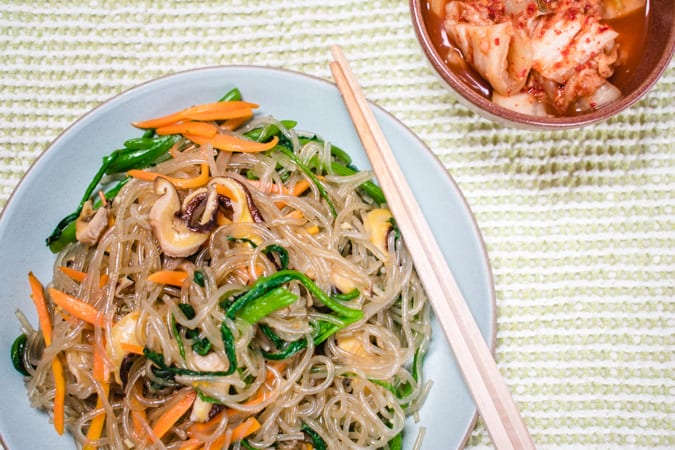
Best Japchae techniques
I researched 3 Korean cookbooks (Practical Korean Cooking, The Korean Kitchen, and Lee Wade's Practical Korean Cookery) for this recipe, they all had these commonalities:
- Rinse the noodles in cold water after cooking
- Stir fry the noodles in the pan. Don’t just toss with the sauce like a salad.
- The seasoning is garlic, sugar, soy sauce/tamari, and sesame oil. Two of the recipes included black pepper.
Spicy japchae recipe
Did you want to make this spicy? That’s an interesting question, since it is not traditionally made spicy. Instead, you would eat it with kimchi or other Korean side dishes.
You could add some jalapenos stir fried. Or better yet, just squeeze on sriracha sauce on top of your plate, so not everyone has to eat it spicy.
Japchae was originally Vegan
In the Korean language, jap means mix and chae means vegetable. Japchae translates to mixed vegetables, and originally, this dish invented in the 17th century was vegan.
According to the Chosun Ilbo: Daily News of Korea, the dish was invented during the Chosun dynasty as a dish for the king's party.
It wasn't until the 20th century that meat and noodles were added. For the 21st century, let's keep the noodles and skip the meat.
How to make Vegan Japchae
Step 1: Boil Water
The first thing you need to do is get a large pot of water on the stove to boil. This may take a while, so get it started while you go to Step 2.
Step 2: Chop vegetables
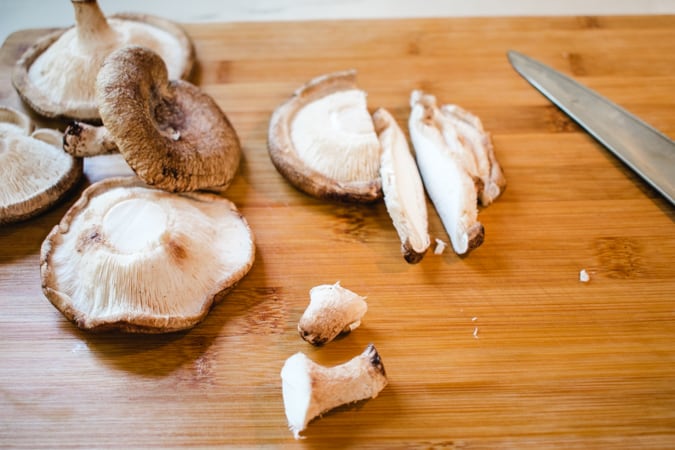
Remove the stem from shiitake mushrooms. (It's too tough to eat). Slice ¼" thick.
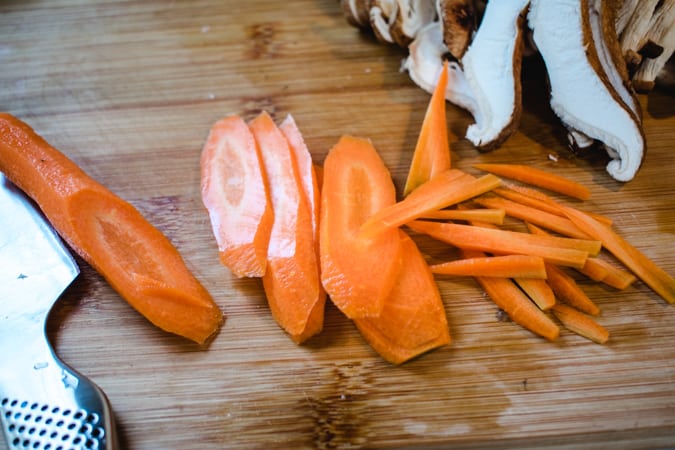
Slice the carrots into matchsticks. You can do this by first slicing on the bias into thin ovals, and then slicing those ovals into matchsticks.
Or buy pre-shredded carrots.
Or use a mandoline.
Or use this julienne cutter.
Seriously, chopping this carrot is the most painful part of this dish.
Do you really have to have the carrot? Since you don't have meat or egg in this dish, yes. It also makes it very "authentic".
Don't forget onion (like I did)! Slice onion ¼" thick.
Step 3: Blanch spinach
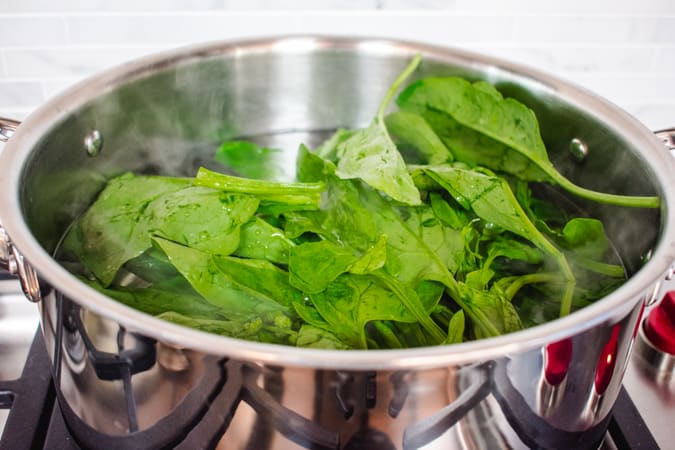
Now the pot should be boiling. Drop in a bunch of washed spinach.
Stir for 30 seconds until the spinach is completely wilted and remove. Leave the pot on the stove to return to a boil for the noodles.
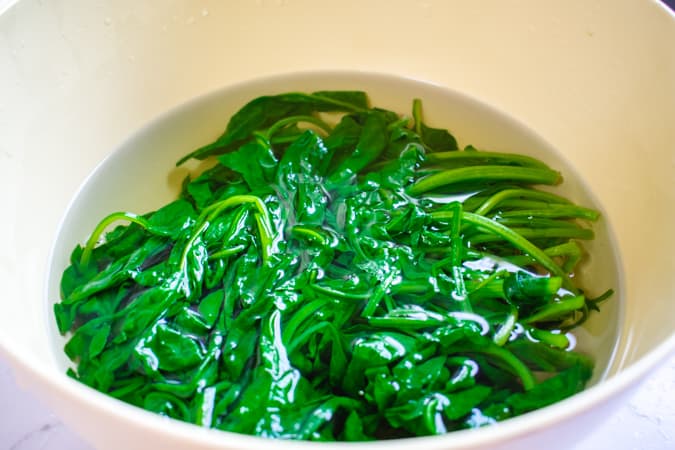
Rinse under cold water to stop the cooking. Ice water would be great if you have it. (I don't).
Drain spinach and squeeze out the excess water. Chop in half to make the pieces a little more bite size. This technique is very much like the popular Korean sesame spinach side dish.
Step 4: Cook noodles

After the pot has returned to a boil, you can use the same water to cook the noodles.
Is that odd? No, it's standard practice in restaurants. There is usually a boiling pot of water is used to cook all types of vegetables, so every cook doesn't have to bring their own pot of water to a boil.
Do you need to presoak the noodles?
According to the package directions for the Sempio brand of noodles, they advise soaking the noodles first in warm water for 20 minutes, and then cooking them in boiling water for 6-7 minutes.
Of course, they don't tell you why you should soak the noodles first but expect you to blindly follow their directions.
My guess is that the noodles are softened, and it makes them easier to thoroughly cook in the boiling water.
Sweet potato noodles are tough, and you do not want to undercook these guys because your noodles will be too chewy.
However, I tried cooking the noodles by soaking first and not soaking and didn't notice much difference.
So, I don't bother to presoak the noodles. I have enough on my mind already, as you probably do too.
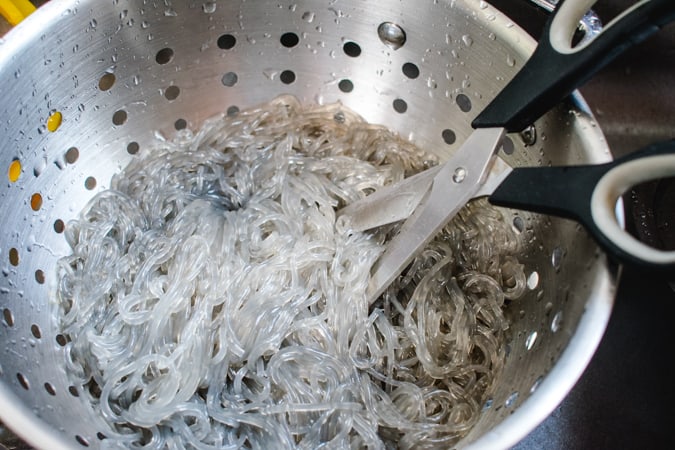
Once the noodles have boiled for 6-7 minutes, taste a strand to make sure it is cooked.
If too chewy, cook for another 1-2 minutes and taste again.
Drain, and rinse under cold water. Then give it a few snips with scissors to make them more manageable to eat.
Do you have to rinse the noodles? No. The shortcut method is to just toss the noodles hot with the seasoning and vegetables.
However, I do find cold stir fries more effectively in the pan than hot ones, and stir frying these noodles results in better flavor.
Step 5: Cook Veggies
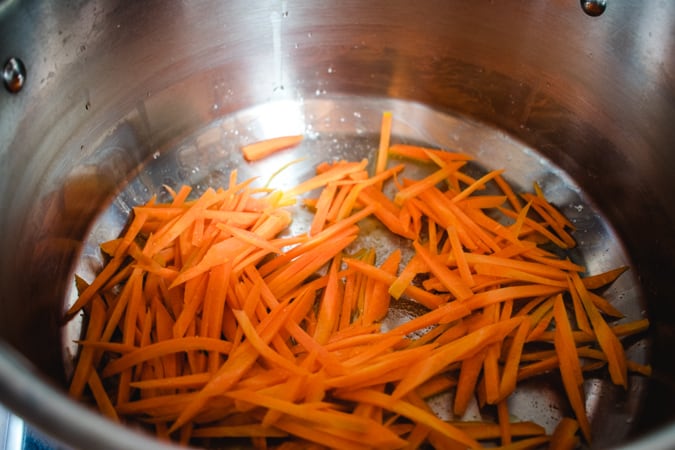
Using the same pot that you boiled the noodles in, return to the stove and bring to medium heat.
Add the oil and onion, and stir fry for 2-3 minutes until the onions loose their rawness. They don't need to be completely soft.
Add the carrots, and stir fry for 2-3 minutes until the carrots are softened. They shouldn't be crunchy but soft.
Also, be sure to add salt. Pro chefs season each element as they go.

Next, add the sliced mushrooms to the pot. Add salt! Since pro chefs season as they go.
Stir fry for 2-3 minutes until the mushrooms are shrunken and shiny from being cooked.

Add the drained, squeezed, and chopped spinach. Stir fry for 1-2 minutes, and do add salt again to season.
Also add the chopped garlic!

Step 4: Stir fry noodles
Now it's time to take this relationship to the next level by adding the drained sweet potato noodles.

Add the sesame oil, soy sauce or tamari, and sugar and stir.
Keep tossing and tossing, else those noodles start sticking.
If it does start to clump together too much, add a touch of water as needed to help loosen up the noodles.
But keep stirring until the sauce has dispersed and the noodles are heated through. This will take 3-5 minutes.
Check for seasoning. Add more soy sauce or tamari if you'd like more saltiness.
Step 5: Serve hot or at room temp

Finally, all that work, and it's time to feast on the fruits of your labor.
Serve hot or at room temperature. This dish is typically eaten at room temperature making it an ideal potluck dish.
If you have leftovers, refrigerate and reheat either by stir frying on the stove or the microwave.
Shortcut Method
If you’re making this for 500 people (as I have in my storied cooking past), there is NO WAY, I’m rinsing the noodles in cold water or stir frying the noodles.
I would instead revert to tossing the ingredients after cooking with the sauce while the noodles are still hot, after they come out of the boiling water. (If for 500, this would be done in a bathtub sized container).
Expert Tips
- Use a nonstick wok/pan or seasoned wok or cast iron pan because these noodles will start to stick.
- Since it can be served at room temperature, this makes an ideal potluck dish.
- If refrigerated, the noodles must be reheated in the microwave or stove top. The noodles will turn brittle and unedible if cold.
- For a shortcut method, skip rinsing the noodles in cold water and stir frying them with the vegetables. Simply mix together the cooked vegetables, sauce, and hot noodles after cooking.
Related Posts
Vegan Korean Black Bean Noodles: Jia Jiang Myeon
Vegan Kimchi Fried Rice is Fast & Luscious
Recipe
Vegan Japchae - Korean Glass Noodles with Vegetables
Ingredients
- 8 oz dried sweet potato noodles or ½ of a 1 lb package
- 1 bu spinach
- 1 Tb oil
- ½ ea onion cut into ¼" thick slices
- 1 ea carrot, large cut into matchsticks
- 1 lb shiitake or woodear mushrooms, julienned rehydrated in hot water if using dried
- 2 ea garlic cloves minced
- 2 Tb soy sauce or tamari for gluten-free option
- 2 Tb sesame oil
- 1 teaspoon sugar or sweetener of choice
- ¼ teaspoon black pepper
Instructions
- Set a large pot of water to boil, and chop vegetables if not already prepped.
- Blanch spinach in the boiling water for 1-2 minutes. Remove from hot water, and rinse under cold water. Squeeze out the excess water and chop in half for more bite sized pieces. Set aside.
- Bring the same pot of water back to a boil. Add the noodles and cook for 6-8 minutes until the noodles are no longer chewy. Drain and rinse under cold water. Cut with scissors a couple times to make the noodles more manageable to stir fry.
- Heat a nonstick pan or other large pan that can accommodate all the noodles under medium high heat. Add the onion and cook for 1-2 minutes to remove some of its rawness. It does not need to be completely soft. Season with a bit of salt.
- Add the carrot to the and cook 2-3 minutes until they start to soften. Season with a bit of salt.
- Add the mushrooms to the pan and cook 2-3 minutes until the mushrooms are shrunken and shiny from being cooked thoroughly. Season with a bit of salt.
- Add the spinach and garlic. Season with a bit of salt. Stir fry for 1-2 minutes for the spinach to heat through. Add a little more oil if your veggies are starting to stick to the pan.
- Add the drained noodles and remaining ingredients to the pan. Cook for 3-5 minutes until the noodles are heated through.
- Season with additional soy sauce/tamari and sesame oil if desired. Serve hot or room temperature.
Notes
- Use a nonstick wok/pan or seasoned wok or cast iron pan because these noodles will start to stick.
- Since it can be served at room temperature, this makes an ideal potluck dish.
- If refrigerated, the noodles must be reheated in the microwave or stove top. The noodles will turn brittle and unedible if cold.
- For a shortcut method, skip rinsing the noodles in cold water and stir frying them with the vegetables. Simply mix together the cooked vegetables, sauce, and hot noodles after cooking.
Nutrition
Do you love Korean japchae noodles? Spread the ♥, and please share! 🙂


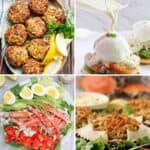
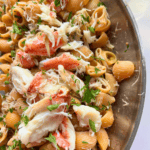

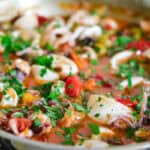
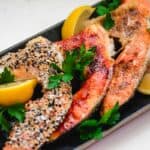







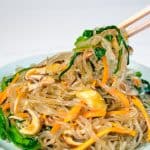
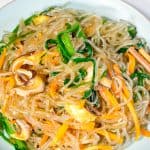




Jessica Formicola says
These noodles are the absolute best! We had them for dinner last night and my whole family loved them!
asiantestkitchen@gmail.com says
Awesome! So glad to hear Jessica!
Lisa Huff says
I'm embarrassed to say I've never had sweet potato noodles. Looks so easy though can't wait to give it a try for dinner sometime.
Andrea Metlika says
This noodle dish looks amazing! The sauce brings all the flavors together. Can't wait to make this.
Anita says
My family sent their thanks! We always order jap chae, so it is very nice to find a comprehensive guide to make it at home.
Jere Cassidy says
What an interesting recipe, I learned about sweet pototo noodles. Hope our World Market has these so I can make this noodle dish.
asiantestkitchen@gmail.com says
Good to know! Thanks so much for stopping by!